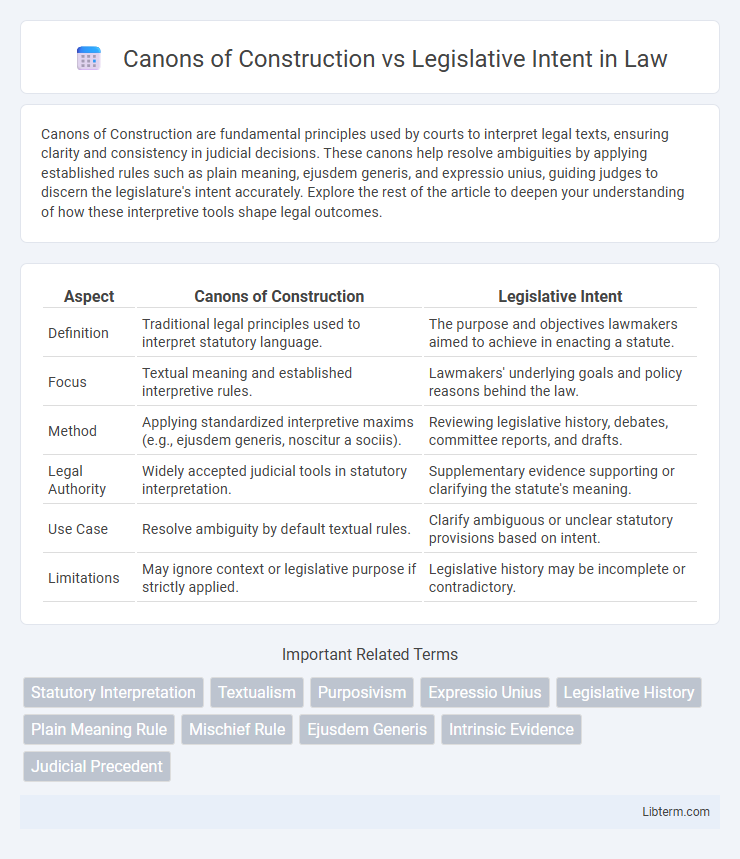Canons of Construction are fundamental principles used by courts to interpret legal texts, ensuring clarity and consistency in judicial decisions. These canons help resolve ambiguities by applying established rules such as plain meaning, ejusdem generis, and expressio unius, guiding judges to discern the legislature's intent accurately. Explore the rest of the article to deepen your understanding of how these interpretive tools shape legal outcomes.
Table of Comparison
| Aspect | Canons of Construction | Legislative Intent |
|---|---|---|
| Definition | Traditional legal principles used to interpret statutory language. | The purpose and objectives lawmakers aimed to achieve in enacting a statute. |
| Focus | Textual meaning and established interpretive rules. | Lawmakers' underlying goals and policy reasons behind the law. |
| Method | Applying standardized interpretive maxims (e.g., ejusdem generis, noscitur a sociis). | Reviewing legislative history, debates, committee reports, and drafts. |
| Legal Authority | Widely accepted judicial tools in statutory interpretation. | Supplementary evidence supporting or clarifying the statute's meaning. |
| Use Case | Resolve ambiguity by default textual rules. | Clarify ambiguous or unclear statutory provisions based on intent. |
| Limitations | May ignore context or legislative purpose if strictly applied. | Legislative history may be incomplete or contradictory. |
Introduction to Statutory Interpretation
Canons of construction serve as established principles and rules that guide courts in interpreting ambiguous statutory language, ensuring consistent application of the law. Legislative intent reflects the purpose and objectives lawmakers aimed to achieve when drafting the statute, often derived from legislative history and context. Balancing canons of construction with legislative intent enables courts to interpret statutes accurately while maintaining fidelity to lawmakers' original goals in statutory interpretation.
Defining Canons of Construction
Canons of construction are established rules and principles used by courts to interpret ambiguous legal texts, ensuring consistent application of the law. These canons prioritize linguistic clarity, statutory context, and legislative purpose to resolve uncertainties in statutory language. Defining canons of construction involves understanding their role as tools to balance strict textual interpretation with broader legislative intent.
Understanding Legislative Intent
Understanding legislative intent involves interpreting statutes based on the purpose and objectives that lawmakers aimed to achieve during the drafting process. Courts analyze legislative history, including committee reports, debates, and the statute's context, to discern the lawmakers' intended meaning beyond the literal text. This approach ensures that the application of laws remains faithful to the goals and remedies envisioned by the legislature.
Historical Evolution of Statutory Interpretation
The historical evolution of statutory interpretation highlights the tension between canons of construction and legislative intent, with early courts relying heavily on rigid canons to apply laws literally while later shifts emphasized discerning lawmakers' purposes. Over time, the balance moved towards integrating legislative intent to resolve ambiguities, reflecting a more purposive approach that acknowledges the complexities of statutory language. This progression underscores how interpretative methods adapt to legal and societal changes, blending textual rules with contextual understanding.
Key Differences Between Canons of Construction and Legislative Intent
Canons of construction are established legal principles judges apply to interpret statutes, aiming to clarify ambiguous language based on traditional rules, whereas legislative intent refers to the actual purpose and objectives lawmakers had when enacting the law. Canons rely on standardized interpretative tools such as textual analysis and statutory context, while determining legislative intent often involves examining legislative history, committee reports, and lawmakers' statements. The key difference lies in canons providing a consistent framework for interpretation regardless of lawmakers' specific goals, whereas legislative intent seeks to uncover the precise reasons behind the statute's creation.
Leading Examples of Canons in Judicial Practice
Leading examples of canons of construction in judicial practice include the plain meaning rule, ejusdem generis, and expressio unius est exclusio alterius. These rules guide courts in interpreting statutory language to resolve ambiguity and ascertain legislative intent. Courts rely on the plain meaning rule to prioritize the ordinary meaning of words, while ejusdem generis limits general terms based on specific examples, and expressio unius excludes items not expressly mentioned, ensuring consistency with legislative intent.
Methods of Determining Legislative Intent
Methods of determining legislative intent include analyzing the text of the statute, reviewing legislative history such as committee reports and floor debates, and examining prior versions of the bill to understand its development. Courts apply canons of construction like the plain meaning rule, ejusdem generis, and noscitur a sociis to interpret ambiguous language while considering legislative intent. Statutory interpretation balances these textual tools with external evidence to ensure laws reflect lawmakers' objectives.
Case Studies Comparing Both Approaches
Case studies such as *King v. Burwell* and *Chevron U.S.A., Inc. v. Natural Resources Defense Council* illustrate the contrast between canons of construction and legislative intent in statutory interpretation. In *King v. Burwell*, the Supreme Court applied a textualist approach using canons of construction to interpret the Affordable Care Act, emphasizing statutory language over suspected legislative intent. Conversely, *Chevron* established a framework prioritizing legislative intent by deferring to agency interpretations when statutes are ambiguous, highlighting different judicial philosophies in balancing textual clarity with the lawmakers' purpose.
Debates and Criticisms Surrounding Each Method
Canons of construction provide structured guidelines for interpreting statutes, but critics argue they can be rigid and sometimes yield results detached from legislative purposes. Legislative intent emphasizes understanding lawmakers' goals, yet detractors point out its speculative nature and difficulty in accurately discerning collective intent. The debate centers on whether courts should prioritize textual canons or the often ambiguous intent behind the law, sparking ongoing scholarly and judicial disputes.
Conclusion: Striking the Balance in Statutory Interpretation
Striking the balance in statutory interpretation requires harmonizing canons of construction with legislative intent to achieve accurate and fair application of the law. Canons provide established linguistic and structural rules, while legislative intent offers insight into the purpose behind the statute, ensuring that legal outcomes align with lawmakers' objectives. Effective interpretation integrates both elements to uphold statutory coherence and judicial consistency.
Canons of Construction Infographic

 libterm.com
libterm.com